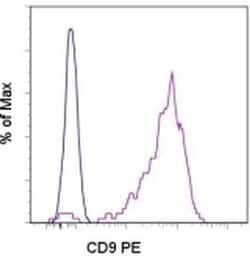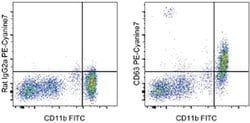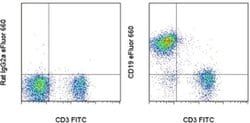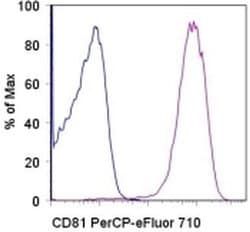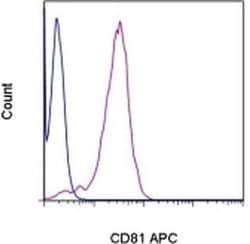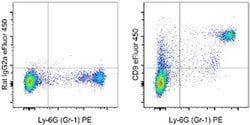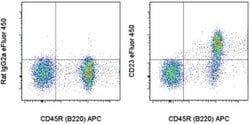CD9 Monoclonal Antibody (eBioKMC8 (KMC8)), eFluor™ 450, eBioscience™, Invitrogen™
Manufacturer: Invitrogen
Select a Size
| Pack Size | SKU | Availability | Price |
|---|---|---|---|
| Each of 1 | 50-112-4088-Each-of-1 | In Stock | ₹ 21,538.00 |
50-112-4088 - Each of 1
In Stock
Quantity
1
Base Price: ₹ 21,538.00
GST (18%): ₹ 3,876.84
Total Price: ₹ 25,414.84
Antigen
CD9
Classification
Monoclonal
Concentration
0.2 mg/mL
Formulation
PBS with 0.09% sodium azide; pH 7.2
Gene Accession No.
P40240
Gene Symbols
CD9
Purification Method
Affinity chromatography
Regulatory Status
RUO
Gene ID (Entrez)
12527
Content And Storage
4° C, store in dark, DO NOT FREEZE!
Form
Liquid
Applications
Flow Cytometry
Clone
eBioKMC8 (KMC8)
Conjugate
eFluor 450
Gene
CD9
Gene Alias
5H9; 5H9 antigen; antigen CD9; BA2; BA-2/p24 antigen; BTCC-1; CD9; CD9 antigen; CD9 antigen (p24); CD9 molecule; cell growth-inhibiting gene 2 protein; DRAP-27; GIG2; Leukocyte antigen MIC3; MIC3; motility related protein-1; Motility-related protein; MRP-1; p24; sCD 9; sCD9; soluble CD 9; soluble CD9; Tetraspanin29; Tetraspanin-29; transmembrane protein CD9; TSPAN29; Tspan-29
Host Species
Rat
Quantity
100 μg
Primary or Secondary
Primary
Target Species
Mouse
Product Type
Antibody
Isotype
IgG2a κ
Description
- Description: The eBioKMC8 monoclonal antibody reacts with mouse CD9, a 24 kDa member of the transmembrane 4 superfamily
- This family is characterized by the presence of four hydrophobic domains spanning the cell membrane and short N- and C-terminal cytoplasmic domains
- CD9 is expressed by several cell types including monocytes, macrophages, platelets, early B cells, activated B and T cells, dendritic cells, eosinophils, basophils, endothelial cells, myoblasts and neuroblasts
- On T cells, CD9 functions as a co-stimulatory molecule on naive T cells
- Furthermore, CD9 is expressed in oocytes, and CD9-deficiency results in sterility caused by defective gamete fusion
- In mouse macrophages, CD9 functionally associates with FcgammaRs to modify signals for phagocytosis and inflammatory responses
- In mouse B cells, it was discovered that CD9 is a marker for marginal zone B cells, B1 cells, and plasma cells
- In dendritic cells, recently it was demonstrated that CD9 facilitates the association of heterologous MHC II molecules
- The level of CD9 expression is subject to donor variability
- Applications Reported: This eBioKMC8 (KMC8) antibody has been reported for use in flow cytometric analysis
- Applications Tested: This eBioKMC8 (KMC8) antibody has been tested by flow cytometric analysis of mouse bone marrow cells
- This can be used at less than or equal to 1 μg per test
- CD9 antigen is a glycoprotein expressed on the surface of developing B lymphocytes, platelets, monocytes, eosinophils, basophil, stimulated T lymphocytes and by neurons and glial cells in the peripheral nervous system
- CD9 belongs to a family of membrane proteins termed tetraspanins which transverse the membrane four times
- In pre B cells and platelets, CD9 antigen regulates cell activation and aggregation possibly through an association with the integrin CD41 / CD61 (GPIIb / GPIIIa)
- CD9 is involved in cell motility, osteoclastogenesis, neurite outgrowth, myotube formation, and sperm-egg fusion, plays roles in cell attachment and proliferation and is necessary for association of heterologous MHC II molecules on the dendritic cell plasma membrane which is important for effective T cell stimulation
- CD9 functions in many cellular processes including differentiation, adhesion, and signal transduction, and expression plays a critical role in the suppression of cancer cell motility and metastasis
- CD9 is also considered as metastasis suppressor in solid tumors.
